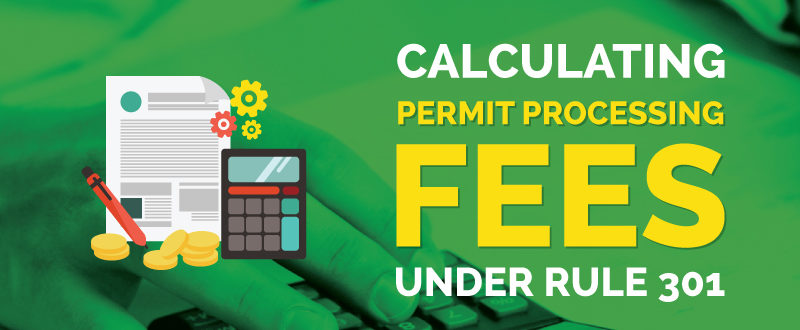
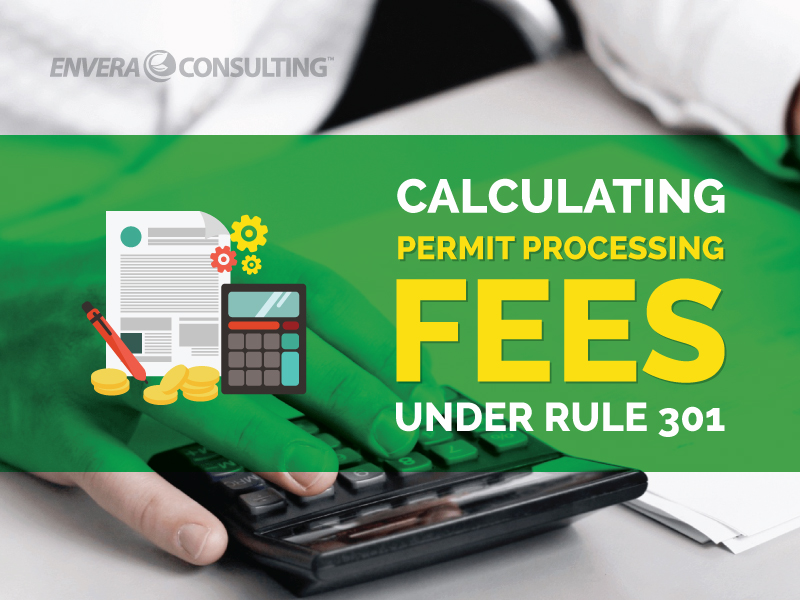
When it comes to SCAQMD air permits, there are three key parts:
- Fees
- Forms
- Engineering evaluation
The SCAQMD is empowered by the California Health and Safety Code to collect permit-application fees, all of which can be found in Rule 301.
The most recent version of Rule 301 (amended June 2, 2017) is a whopping (and sleep-inducing) ninety pages.
If you’re preparing to submit a permit application and want to know how much your fees are, you have two choices. You can either read through those ninety pages or just enjoy the simple six-step synopsis below.
Step 1: Determine the Type of Permit Application You’re Submitting
Generally speaking, there are four different types of permit applications that can be submitted to the SCAQMD:
- General permit processing — one of the most common applications, this is typically used to obtain a permit-to-construct for new equipment or a permit-to-operate for existing equipment.
- Change of condition — application that is used to change a condition on an existing permit for equipment that will not be physically modified and not result in an increase of emissions.
- Permit modification/alteration — application that is used to request a permit for equipment that will be physically modified.
- Administrative change — application that is used to request a change to the permit, typically to fix a typographical error, remove the permit-to-construct terms that are no longer applicable, or change the monitoring/recordkeeping conditions (if there is a mistake on the permit).
Step 2: Determine the Type of Rule 301 Equipment You’re Permitting
Once you know the type of application you’re applying for, you need to determine the fee schedule for your equipment and/or process.
Not all equipment or processes are created equal. Fees may be different for the same type of equipment if more material is processed or if multiple processes vent to one control. There’s an indefinite number of scenarios, meaning fees can vary greatly. As such, equipment and processes are separated by fee schedules, which serve as “levels.” As you might expect, higher schedules pay larger fees.
The SCAQMD has cataloged equipment and process fee schedules in Rule 301. The associated schedule for control equipment can be found in Tables 1A (found on pages 73–75 of Rule 301), while the one for basic equipment can be found in Table 1B (pages 76-89).
Yes, the tables are confusing and you’re going to want to get through them as quickly as possible, but you need to take your time to ensure you determine the correct equipment schedule. Incorrectly estimating the application fees can delay the permitting process.
Below is a snippet of the otherwise ginormous Table 1A.
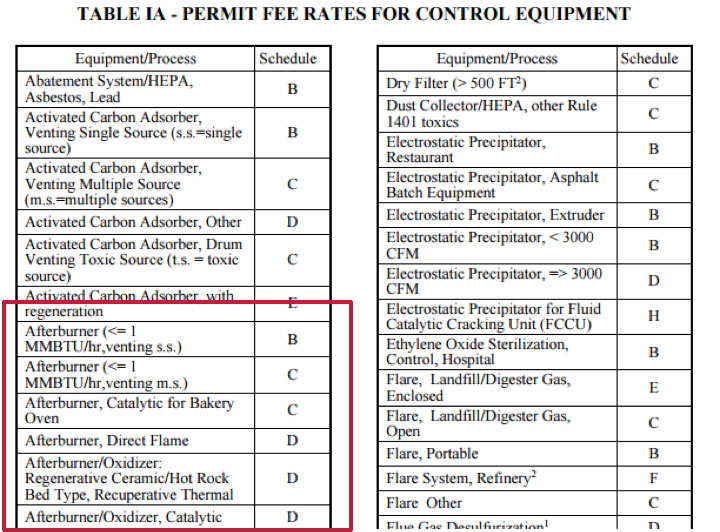
In the red box above, we see six different afterburner categories, each following a different fee schedule. Generally, if an afterburner is rated at less than 1,000,000 BTU/hr and is venting one source, it will follow the second lowest schedule (Schedule B). If the same afterburner vents two sources, it moves up a level to follow Schedule C.
The reason an afterburner is used may also affect the fee schedule. Some processes may have a higher potential to emit and thus follow a higher fee schedule. For instance, if a catalytic oxidizer is venting a bakery oven, then it will follow Schedule C. If the catalytic oxidizer vents anything other than a bakery oven, it will follow Schedule D.
If you are unable to find your specific equipment or process in Tables 1A or 1B, the associated fees are based on Schedule C (page 9).
Step 3: Determine the Base Fees According to the Equipment Type and Application Type You’re Submitting
Now that you know your equipment type and its associated fee schedule, you need to correlate it to one of the ten fee schedules in the handy-dandy tables below.
The tables relate the ten fee schedules to the first three types of permit applications mentioned in Step 1. Note that the fees vary depending on if your facility is in the Title V program.
Once you know the fee schedule of the equipment that you are permitting, as well as the type of application you are submitting, you can determine the base fees by looking them up in the tables below.
For fiscal year (FY) 2017-2018, the fees for permit processing, change of condition, and alteration/modification applications (found on page 68 of Rule 301) are as follows:
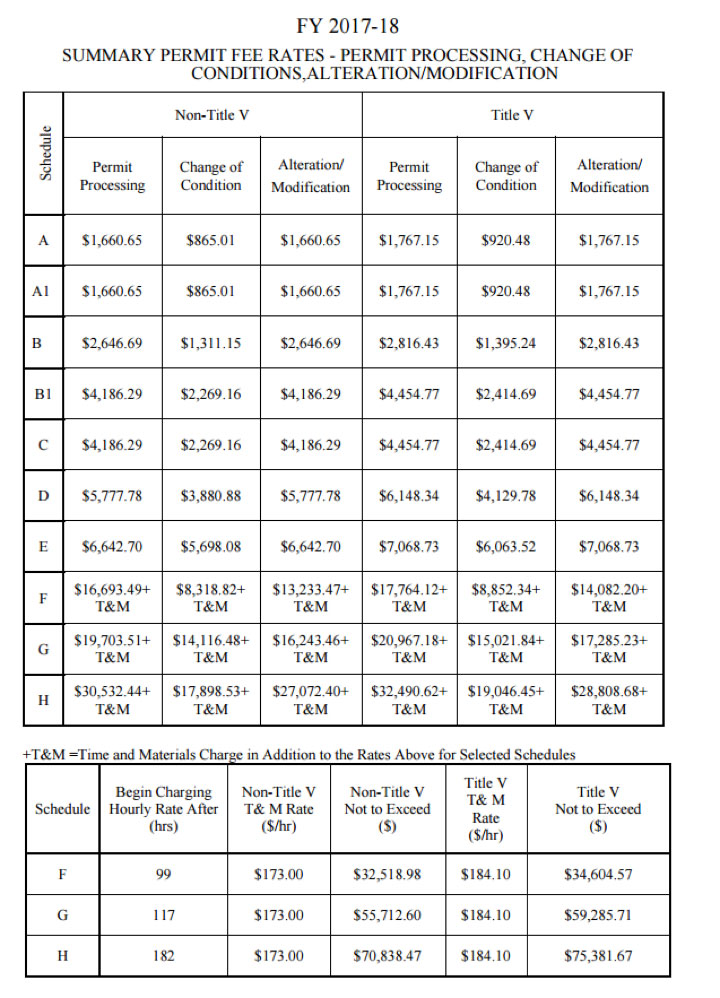
For example, if you are a non-Title V facility with a piece of equipment that falls under Schedule B and are submitting an application for a change of condition, your base fee would be $1,311.15 during FY 17-18.
On the other hand, if you are a Title V facility with a piece of equipment that falls under Schedule H and you’re submitting an application for a permit modification/alteration, your base fee would be $28,808.68 plus an hourly rate for time and materials (T&M) starting after a time threshold.
T&M charges for FY 2017-18 Schedules F-H can be found in the following table.
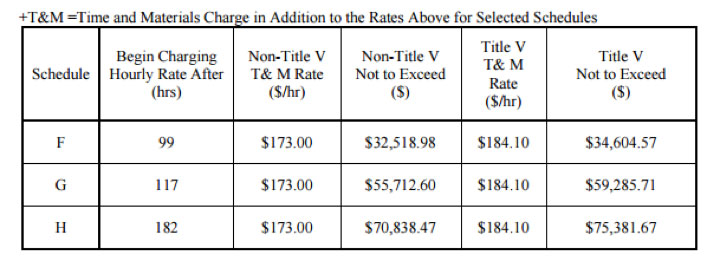
With the amendments to the June 2017 rule amendments, the SCAQMD also provided the associated fee schedule for FY 2018-19 and FY 2019-20 (and onward). Though they are not tabulated above, they can be found on pages 69-70 of Rule 301.
For administrative changes (the fourth type of application mentioned in Step 1), you still need to know the fee schedule; however, the lookup table is in a different part of Rule 301, specifically Section (c)(3)(C) (found on page 17).
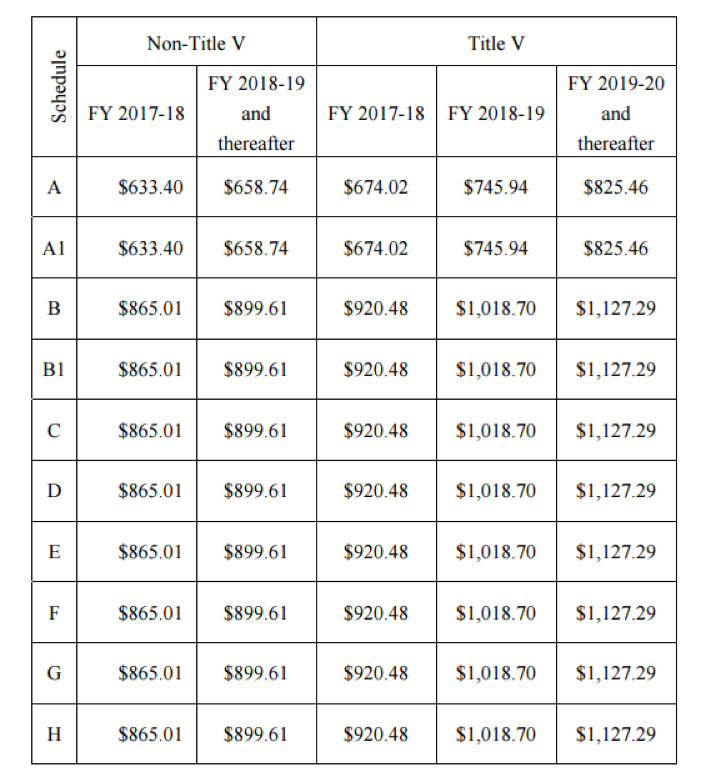
Step 4: Identify Any Fee Modifiers and Determine the Appropriate Fee for Each
Base fees can be modified depending on the situation. Here is a list of the five most common fee modifiers, or cases:
Case 1: Higher Fees for Failing to First Obtain a Permit to Construct
In this case, you’ve already built a piece of equipment and it’s in operation without an SCAQMD construction permit. For whatever reason, you’re now submitting a permit application for this piece of equipment.
Most times when this happens, folks realize they need a permit for their equipment before the SCAQMD issues a notice of violation (NOV) for not having a permit.
In these cases, the fee for the equipment is 150 percent of what’s listed in the summary table. That extra 50 percent can be viewed as a penalty for not first obtaining a permit to construct according to Rule 201.
Rule 301 also lists cases, such as with small businesses, where a facility is not required to pay the fee modifier of 150 percent. See Section (c)(1)(D) (page 10) for more info.
IMPORTANT: Even after paying the 50-percent penalty, you’re not off the hook: The SCAQMD can still issue an NOV, according to Rule 201.
Case 2: The Small Business Discount
The Rule 102 definition of a small business is an entity that has fewer than ten employees and less than $500,000 in gross receipts, or that is registered as a nonprofit. Organizations that meet these conditions can make use of a 50-percent discount of the fee listed in the summary table.
Case 3: The Identical Equipment Discount
If you’re submitting multiple applications for the same type of equipment, you may be entitled to a discount. Rule 301(b)(20) defines “identical equipment” as follows:
IDENTICAL EQUIPMENT means any equipment which is to be operated by the same operator, and have the same equipment address, and have the same operating conditions and processing material to the extent that a single permit evaluation would be required for the set of equipment. Portable equipment, while not operating at the same location, may qualify as identical equipment.
When permitting multiple pieces of identical equipment, you pay the full fees on the first unit and 50 percent off each additional identical unit.
Let’s say you have a project that requires you to permit 50 identical engines. You first need to submit the permit applications for all 50 engines at the same time, then pay the full permit price for the first engine and 50 percent of the price for the other 49.
It’s important to note that if you qualify for both the small business and identical equipment discount, the larger of the two discounts is applied.
Case 4: Discount for Equipment Previously Exempt Under Rule 219
Equipment listed in Rule 219 is exempt from permitting requirements. However, amendments made to this rule have now made some exempt equipment nonexempt, meaning it’s possible equipment that once did not need a permit does so now.
If your equipment now requires a permit due to the amendments made to this rule, the permit processing fees are the same as that in Table 1, Schedule A, even if the equipment fits into another schedule.
Case 5: Higher Fees for Expedited Permit Processing
Because of a condition made by the California Permit Streamlining Act, you can expedite the processing of your permit application. If you want to do this in the SCAQMD, it will require additional fees — namely, 150 percent of the amount listed in the summary table.
Step 5: Determine Any Facility Permit Fees
Sometimes you need to modify a facility permit, such as one that falls under RECLAIM and/or Title V. If your facility has such a permit, then each time you submit a permit application, you also need to modify your facility permit to account for the new equipment being permitted. The fees to amend the facility permit, which are due at the same time as the permit processing fees, depend on which program your permit is associated with (Title V and/or RECLAIM).
So, if you have a RECLAIM or Title V permit, the facility permit modification with an engineering evaluation costs $1,088.60 for FY 2017-18 (see Table VII on pages 95-96 of Rule 301, which has been replicated below).
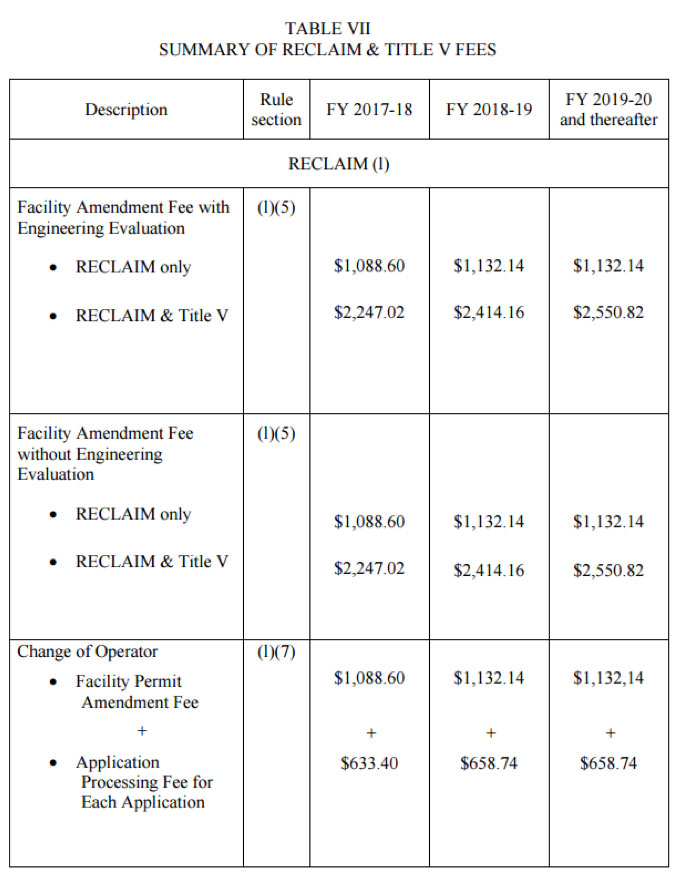
On the other hand, if your facility is in both RECLAIM and Title V, the permit modification costs $2,247.02 for FY 2017-18.
Step 6: Calculate the Grand Total for the Permit Processing Fees
This is where you add together all the fees you calculated above. The SCAQMD also has a fee calculator you can use to calculate the permit processing fees. While this application is valuable and saves time, I highly recommend that you learn how to determine the fees “by hand” so that you understand the components of a fee calculation. You can then use the SCAQMD calculator to double-check your work.